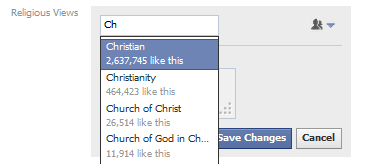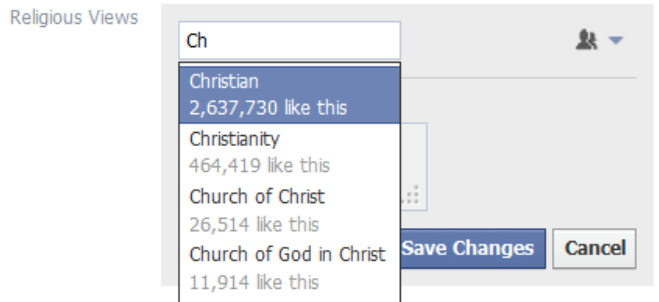For fields such as Work, Religion, Political affiliation, and Education, Facebook uses what are called validated fields. This means that as you begin to type, the site will suggest options.
This functionality could be problematic if users’ actual choices do not show up first or do not show up on Facebook’s lists at all. Privileging certain choices over others, by listing some first or by not listing others at all, implies that Facebook values certain choices over others, or finds certain choices more “normal” than others.
You don’t have to fill in these spaces. In fact, you can choose to leave them completely blank and instead explain these aspects of yourself through the open-ended “About Me” section.
<
>
Close X

For those of us who saw the movie “The Social Network,” apparently adding relationship status to the site was the field that made the site popular. Whether or not this is true, relationship status on Facebook has become an important part of relationships in general, both online and offline.
Often, we hear that a relationship isn’t real until it is “Facebook official.” While funny, this also shows the power the site has to define what we think is real and what we take with a grain of salt.
Although Facebook added relationship statuses such as “it’s complicated” and “in an open relationship,” the site still only allows each user to be in one relationship.
Further, Facebook has defined which changes in relationship statuses are to be celebrated and which are to be hidden. For example, if I change my status from “engaged” to “married” Facebook automatically creates a Life Event and posts the status change on my Timeline. On the other hand, if I change my status from “married” to “divorced,” the site shows a message of “This will not appear in News Feed,” implying that the change is not something to be celebrated or even made public. This automatic setting is questionable since many recently-divorced people admit that completing the divorce process can be a positive milestone for many different reasons.
<
>
Close X

Like relationship statuses, users can choose to display familial relationships by choosing a relationship and linking it to another user. If you want to add a family member, they have to be your Facebook friend. You have to select a relationship, meaning, you can’t add Jane as a family member without specifying how she is related to you.
If a user has a gender selected, Facebook limits the type of family member you can list her as. Also, many familial relationships are not included such as godmother, godfather, great aunt, and great uncle. While these relationships may be important to some people, Facebook implies that they are not “important” relationships and thus shouldn't be listed in the family section.
There are many ways to get around Facebook’s expected usage of the family section. You can list people as family members who are not. I have seen friends listing each other as siblings or listing people who are their mentors are parents. You can also create a culture of selecting a neutral gender and posting that a “female” friend is a “male” cousin or “brother,” and so on.
<
>
Close X
Facebook’s About page works as a traditional profile page that lists personal information about users. While logged in, Facebook prompts users to fill in as much of their profiles as possible. In fact, when users first sign up, the site keeps a status bar of profile progress, letting new users know when they have “completed” 100% their profiles. Although Facebook offers many fields to customize, users should also be aware of the potentially limiting choices provided. Below are a few examples of the ways Facebook controls identity on the About page.
Click the images below for more information:

validated fields

relationship status

family





